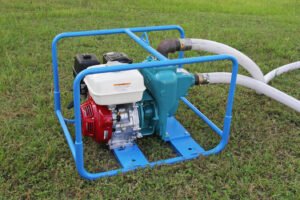The mud pump is the heart of mud rotary drilling. This crucial piece of equipment is responsible for removing the cuttings produced when drilling a water well. Sure, on the surface, the mud pump might not be the most exciting part of a water well drilling rig. But if your crew relies on mud rotary drilling methods, your operation will literally be stuck in the mud without the proper mud pump — no matter how much horsepower and torque your drill sends down the borehole.
To better understand why the mud pump should be a key consideration when selecting a water well drill we need to take a closer look at this un-sung hero of water well drilling.
How does it work?
 First, we need to know how a mud pump works. Mud pumps rely on centrifugal force to create suction. This suction helps move water through the pump and down the borehole to help flush out the cuttings. The pump itself is relatively simple. The whole thing is powered by an engine. Once the operator starts the engine, it powers the rotation of a connected drive assembly. This, in turn, rotates the pump’s internal impeller — creating the centrifugal force which pulls water through the inlet into the impeller blades and then forces it through the outlet.
First, we need to know how a mud pump works. Mud pumps rely on centrifugal force to create suction. This suction helps move water through the pump and down the borehole to help flush out the cuttings. The pump itself is relatively simple. The whole thing is powered by an engine. Once the operator starts the engine, it powers the rotation of a connected drive assembly. This, in turn, rotates the pump’s internal impeller — creating the centrifugal force which pulls water through the inlet into the impeller blades and then forces it through the outlet.
Why is it important for rotary water well drilling?
Despite its simplicity, the humble mud pump plays an important part in overall drilling efficiency. As crew members drill, the drill bit produces cuttings. These pile up in the bottom of the borehole and prevent crews from making progress – like trying to dig a hole with a shovel but throwing the dirt back into the hole every time. Mud pumps offer a solution.
Water is pumped from the mud pump to the drill pipe where it exits through the holes in the drill bit — which may be several inches or hundreds of feet deep in the borehole. Water fills the borehole, forcing the loose cuttings up and out of the hole.
 Crews can drill as quickly as the mud pump can force water into the hole to remove the cuttings, so having a robust mud pump is essential for fast, efficient drilling. An inadequate mud pump, or a drill design that neglects the pump’s importance, can slow down operations to a snail’s pace. This is where Lone Star Drills’ decades of industry experience supporting water well missions and continuously incorporating crews’ feedback into product development come into play.
Crews can drill as quickly as the mud pump can force water into the hole to remove the cuttings, so having a robust mud pump is essential for fast, efficient drilling. An inadequate mud pump, or a drill design that neglects the pump’s importance, can slow down operations to a snail’s pace. This is where Lone Star Drills’ decades of industry experience supporting water well missions and continuously incorporating crews’ feedback into product development come into play.
What specs should I focus on for adequate drilling support?
While numbers like horsepower are important, far too often manufacturers over value these performance specs at the cost of efficiency.
Instead, we put the drilling process first. Lone Star Drills has spent decades growing its drill lineup based not just on specs, but on grueling real-world performance. No one knows better than the person in the field, so we’re constantly sending out new mud pumps and new designs to our customers across the globe and innovating our mud pumps to maximize efficiency.
But keep in mind the mud pump is only part of the overall water well drilling rig. How the whole system works together will determine water well drilling effectiveness. For example, our drills incorporate a three-way valve with a bypass so crews can quickly divert the flow of water from the mud pump, add drill pipe, reconnect water flow and continue drilling all within seconds. Drills that don’t have this feature require crews to fully shut down the mud pump to stop water flow, add drill pipe and power back on the mud pump to restart water flow — a burdensome process for deep wells that require dozens of pipe sections.
Un-Muddying the Water
Proper mud pump pairing is the key to efficient water well drilling. That’s why Lone Star Drills offers a variety of mud pumps to match the drill for optimal performance. We offer both gasoline- and diesel-powered pumps offering up to 13 horsepower for achieving greater depths.
In addition to flushing cuttings, the mud pump helps stabilize the borehole, as the mixture of water and mud keeps it from collapsing. Using the mud pump, crews can even add bentonite to the pumped water to create a coating that binds to the borehole walls and prevents water from escaping.
With so much riding on your mud pump, careful equipment selection is important. Contact our team to learn more about your mud pump options.